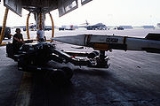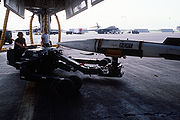
AGM-69 SRAM
Encyclopedia

Boeing
The Boeing Company is an American multinational aerospace and defense corporation, founded in 1916 by William E. Boeing in Seattle, Washington. Boeing has expanded over the years, merging with McDonnell Douglas in 1997. Boeing Corporate headquarters has been in Chicago, Illinois since 2001...
AGM-69 SRAM (Short-range attack missile) was a nuclear
Nuclear weapon
A nuclear weapon is an explosive device that derives its destructive force from nuclear reactions, either fission or a combination of fission and fusion. Both reactions release vast quantities of energy from relatively small amounts of matter. The first fission bomb test released the same amount...
air-to-surface missile
Air-to-surface missile
An air-to-surface missile is a missile designed to be launched from military aircraft and strike ground targets on land, at sea, or both...
designed to replace the older AGM-28 Hound Dog
AGM-28 Hound Dog
The North American Aviation Corporation AGM-28 Hound Dog was a supersonic, jet propelled, air-launched cruise missile. The Hound Dog missile was first given the designation B-77, then redesignated the GAM-77, and finally designated the AGM-28, permanently...
stand-off missile
Stand-off missile
Standoff missiles are missiles "which may be launched at a distance sufficient to allow attacking personnel to evade defensive fire from the target area." Typically, they are used against land- and sea-based targets in an offensive operation...
.
The requirement for the weapon was issued by the Strategic Air Command
Strategic Air Command
The Strategic Air Command was both a Major Command of the United States Air Force and a "specified command" of the United States Department of Defense. SAC was the operational establishment in charge of America's land-based strategic bomber aircraft and land-based intercontinental ballistic...
of the USAF in 1964, and the resultant AGM-69A SRAM entered service in 1972. It was carried by the B-52
B-52 Stratofortress
The Boeing B-52 Stratofortress is a long-range, subsonic, jet-powered strategic bomber operated by the United States Air Force since the 1950s. The B-52 was designed and built by Boeing, who have continued to provide maintainence and upgrades to the aircraft in service...
, the FB-111A, and, for a very short period starting in 1986, by the B-1Bs
B-1 Lancer
The Rockwell B-1 LancerThe name "Lancer" is only applied to the B-1B version, after the program was revived. is a four-engine variable-sweep wing strategic bomber used by the United States Air Force...
based at Dyess AFB in Texas
Texas
Texas is the second largest U.S. state by both area and population, and the largest state by area in the contiguous United States.The name, based on the Caddo word "Tejas" meaning "friends" or "allies", was applied by the Spanish to the Caddo themselves and to the region of their settlement in...
. SRAMs were also carried by the B-1Bs
B-1 Lancer
The Rockwell B-1 LancerThe name "Lancer" is only applied to the B-1B version, after the program was revived. is a four-engine variable-sweep wing strategic bomber used by the United States Air Force...
based at Ellsworth AFB in South Dakota
South Dakota
South Dakota is a state located in the Midwestern region of the United States. It is named after the Lakota and Dakota Sioux American Indian tribes. Once a part of Dakota Territory, South Dakota became a state on November 2, 1889. The state has an area of and an estimated population of just over...
, Grand Forks AFB in North Dakota
North Dakota
North Dakota is a state located in the Midwestern region of the United States of America, along the Canadian border. The state is bordered by Canada to the north, Minnesota to the east, South Dakota to the south and Montana to the west. North Dakota is the 19th-largest state by area in the U.S....
, and McConnell AFB in Kansas
Kansas
Kansas is a US state located in the Midwestern United States. It is named after the Kansas River which flows through it, which in turn was named after the Kansa Native American tribe, which inhabited the area. The tribe's name is often said to mean "people of the wind" or "people of the south...
up until late 1993.
SRAM had an inertial navigation system as well as a radar altimeter which enabled the missile to be launched in either a semi-ballistic or terrain-following flight path. The SRAM was also capable of performing one "major maneuver" during its flight which gave the missile the capability of reversing its course and attacking targets that were behind it, sometimes called an "over-the-shoulder" launch. The missile had a Circular Error Probable
Circular error probable
In the military science of ballistics, circular error probable is an intuitive measure of a weapon system's precision...
(CEP) of about 1,400 ft (430 m) and a maximum range of 110 nautical miles (203.7 km). The SRAM used a single W69
W69
W69 is a United States nuclear warhead used in AGM-69 SRAM Short-Range Attack Missiles.It was designed in the early 1970s and produced from 1974 to 1976. It remained in service until 1991, with the last units being retired in 1996...
nuclear warhead with a variable yield
Variable yield
Variable yield — or dial-a-yield — is an option available on most modern nuclear weapons. It allows the operator to specify a weapon's yield, or explosive power, allowing a single design to be used in different situations...
of 17 kilotons as a fission weapon, or 210 kilotons as a fusion weapon with Tritium
Tritium
Tritium is a radioactive isotope of hydrogen. The nucleus of tritium contains one proton and two neutrons, whereas the nucleus of protium contains one proton and no neutrons...
boost enabled. The aircrew could turn a switch on the Class III command to select the destructive yield required.
The SRAM missile was completely coated with 2 cm of soft rubber, used to absorb radar energy and also dissipate heat during flight. The three fins on the tail were made of a phenolic material, also designed to minimize any reflected radar energy. All electronics, wiring, and several safety devices were routed along the top of the missile, inside a raceway.
On the B-52, SRAMs were carried externally on 2 wing pylons (6 missiles on each pylon) and internally on an eight-round rotary launcher mounted in the bomb bay; maximum loadout was 20 missiles. The B-1B could carry 8 missiles on up to three rotary launchers (one in each of its three stores bays) for a maximum loadout of 24 missiles. The FB-111A could carry two missiles internally and four more missiles under the aircraft's swing-wing. On the FB-111A, the externally-mounted missiles required the addition of a tailcone to reduce aerodynamic drag during supersonic flight. Upon rocket motor ignition, this tailcone was blown away by the exhaust plume.
About 1,500 missiles were built at a cost of about $592,000 each by the time production ended in 1975. The Boeing Company sub-contracted with the Lockheed Propulsion Company
Lockheed Propulsion Company
The Lockheed Propulsion Company was a division of the Lockheed Aircraft Corporation located in the Mentone, California area northeast of Redlands, California, adjacent to the Santa Ana River, from 1961 to 1975...
for the propellants, which subsequently closed with the end of the SRAM program.
An upgraded AGM-69B was proposed in the late 1970s, with an upgraded motor to be built by Thiokol
Thiokol
Thiokol is a U.S. corporation concerned initially with rubber and related chemicals, and later with rocket and missile propulsion systems...
and a W80 warhead, but it was cancelled (along with the B-1A) in 1978. Various plans for alternative guidance schemes, including an anti-radar
Anti-radiation missile
An anti-radiation missile is a missile which is designed to detect and home on an enemy radio emission source. Typically these are designed for use against an enemy radar, although jammers and even radios used for communication can also be targeted in this manner.- Air-to-Ground :Most ARM designs...
seeker for use against air defense installations and even a possible air-to-air missile
Air-to-air missile
An air-to-air missile is a missile fired from an aircraft for the purpose of destroying another aircraft. AAMs are typically powered by one or more rocket motors, usually solid fuelled but sometimes liquid fuelled...
version, came to nothing.
A new weapon, the AGM-131 SRAM II
AGM-131 SRAM II
The SRAM II was a nuclear air-to-surface missile intended as a replacement for the AGM-69 SRAM, but it was cancelled by President George H.W...
, began development in 1981, intended to arm the resurrected B-1B, but it was cancelled in 1991 by then president George H. W. Bush
George H. W. Bush
George Herbert Walker Bush is an American politician who served as the 41st President of the United States . He had previously served as the 43rd Vice President of the United States , a congressman, an ambassador, and Director of Central Intelligence.Bush was born in Milton, Massachusetts, to...
along with most of the U.S. Strategic Modernization effort (including Peacekeeper Mobile (Rail) Garrison, Small ICBM and Minuteman III modernization) in an effort by the U.S. to ease nuclear pressure on the disintegrating Soviet Union.
The AGM-69A was finally retired in 1993 over growing concerns about the safety of its warhead and rocket motor. With the end of the Cold War
Cold War
The Cold War was the continuing state from roughly 1946 to 1991 of political conflict, military tension, proxy wars, and economic competition between the Communist World—primarily the Soviet Union and its satellite states and allies—and the powers of the Western world, primarily the United States...
it is unlikely to be replaced in the immediate future. There were serious concerns about the solid rocket motor, when several motors suffered cracking of the propellant, thought to occur due to the hot/cold cycling year after year. Cracks in the propellant could cause catastrophic failure once ignited.
The SRAM was effectively replaced by the ALCM cruise missile, which has longer range, though easier to intercept.
Service history
The number of AGM-69 missiles in service, by year:- 1972 - 227
- 1973 - 651
- 1974 - 1149
- 1975 - 1451
- 1976 - 1431
- 1977 - 1415
- 1978 - 1408
- 1979 - 1396
- 1980 - 1383
- 1981 - 1374
- 1982 - 1332
- 1983 - 1327
- 1984 - 1309
- 1985 - 1309
- 1986 - 1128
- 1987 - 1125
- 1988 - 1138
- 1989 - 1120
- 1990 - 1048 (deactivated by President George H.W. Bush)
Specifications
- Length: 190 in. (4.83 m) with tail fairing, 168 in. (4.27 m) without tail fairing
- Diameter: 17.5 in. (445 mm)
- Wing span: 30 in (760 mm)
- Launch weight: 2,230 lb (1010 kg)
- Maximum speed: Mach 3.5
- Maximum range: 35-105 statute miles (56–169 km) depending on flight profile
- Powerplant: 1 × LockheedLockheed CorporationThe Lockheed Corporation was an American aerospace company. Lockheed was founded in 1912 and later merged with Martin Marietta to form Lockheed Martin in 1995.-Origins:...
SR75-LP-1 two stage solid-fuel rocket motor - Guidance: General Precision/Kearfott KT-76 inertial and Stewart-Warner radar altimeter
- CEPCircular error probableIn the military science of ballistics, circular error probable is an intuitive measure of a weapon system's precision...
: 1,400 ft (430 m) - Warhead: W69W69W69 is a United States nuclear warhead used in AGM-69 SRAM Short-Range Attack Missiles.It was designed in the early 1970s and produced from 1974 to 1976. It remained in service until 1991, with the last units being retired in 1996...
thermonuclear (170-200 kt of TNT)

